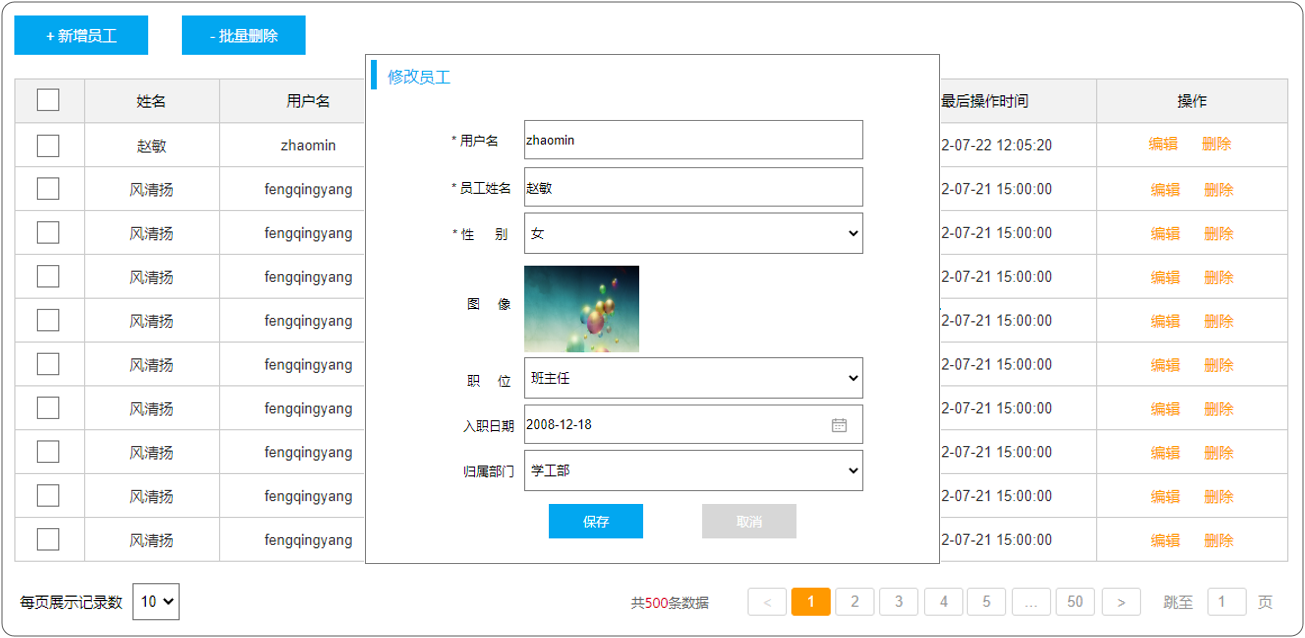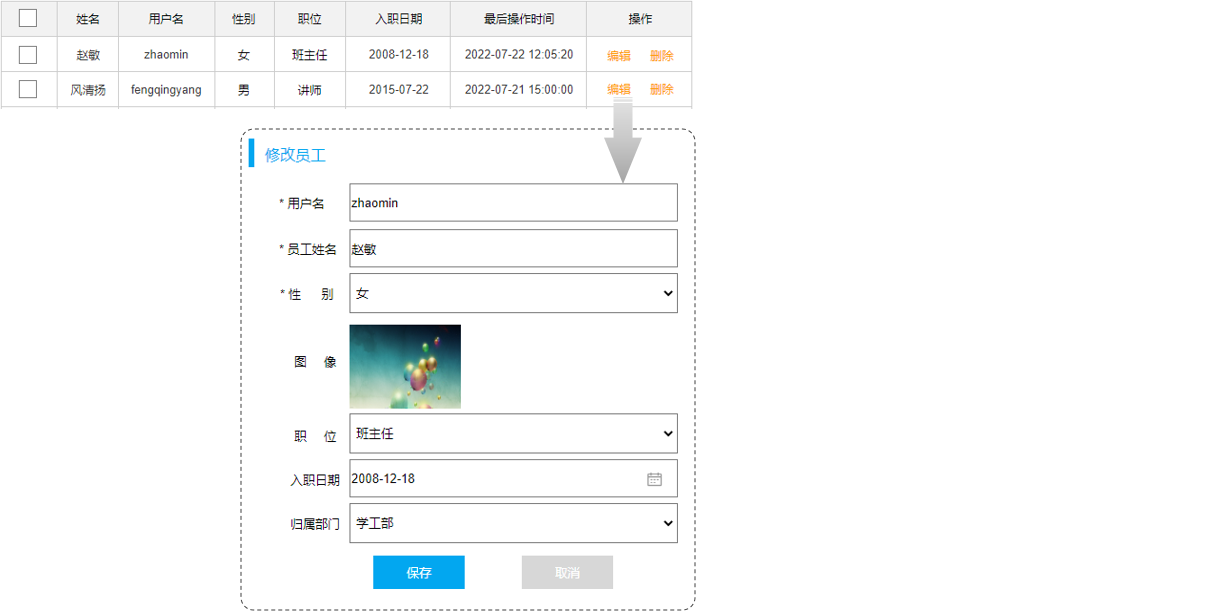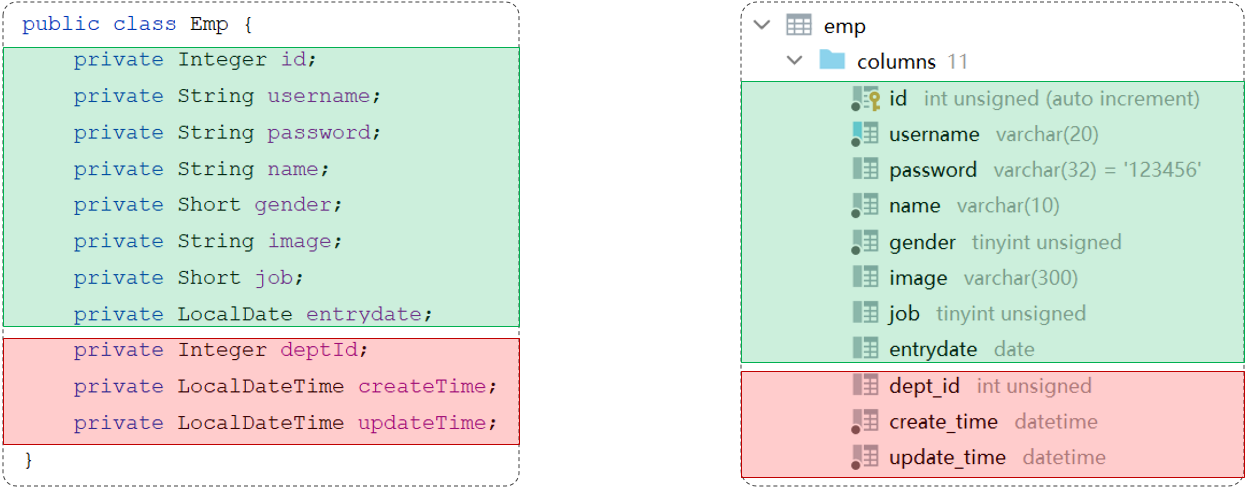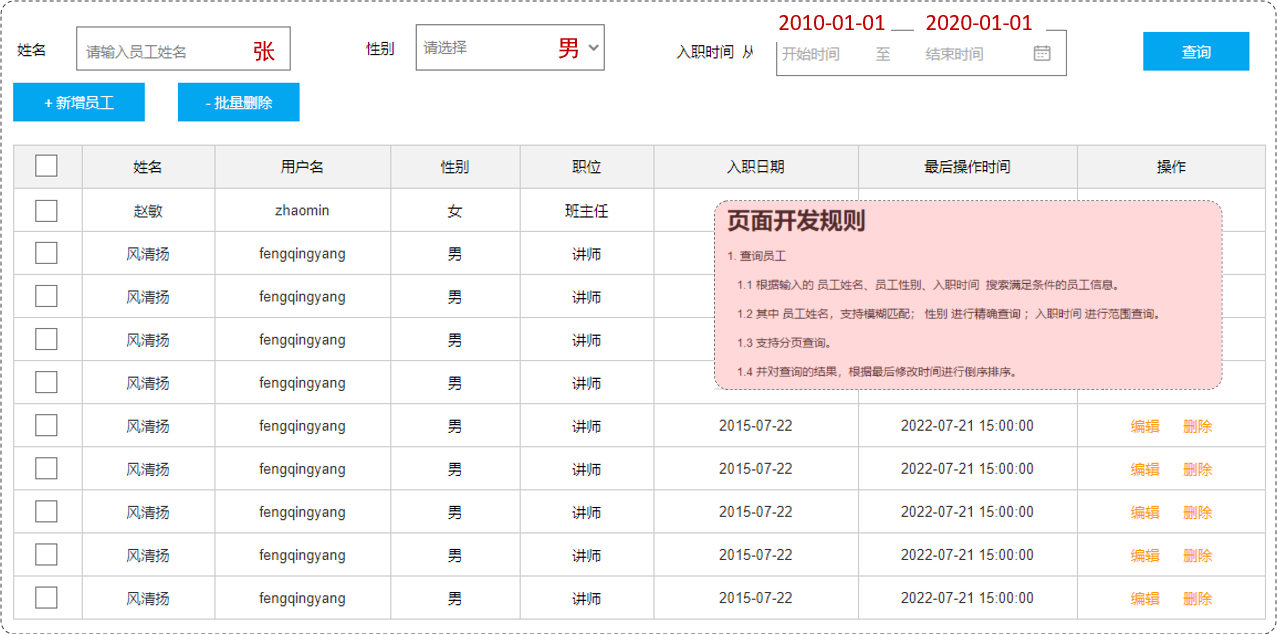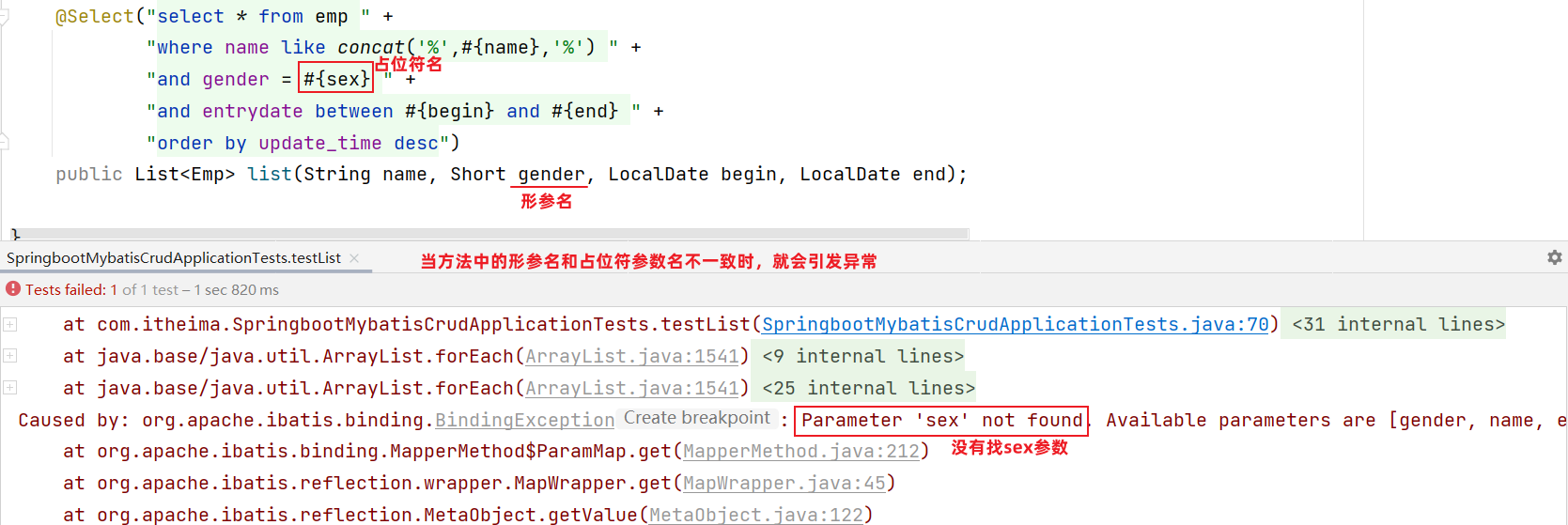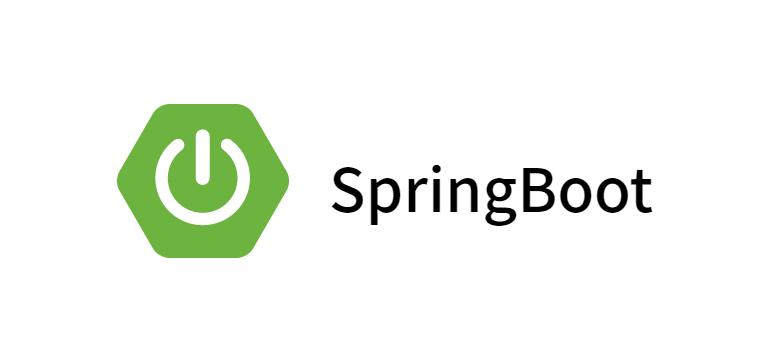1.5 更新 功能:修改员工信息
点击”编辑”按钮后,会查询所在行记录的员工信息,并把员工信息回显在修改员工的窗体上(下个知识点学习)
在修改员工的窗体上,可以修改的员工数据:用户名、员工姓名、性别、图像、职位、入职日期、归属部门
思考:在修改员工数据时,要以什么做为条件呢?
答案:员工id
SQL语句:
update emp set username = 'linghushaoxia' , name = '令狐少侠' , gender = 1 , image = '1.jpg' , job = 2 , entrydate = '2012-01-01' , dept_id = 2 , update_time = '2022-10-01 12:12:12' where id = 18 ;
接口方法:
@Mapper public interface EmpMapper { @Update("update emp set username=#{username}, name=#{name}, gender=#{gender}, image=#{image}, job=#{job}, entrydate=#{entrydate}, dept_id=#{deptId}, update_time=#{updateTime} where id=#{id}") public void update (Emp emp) ; }
测试类:
@SpringBootTest class SpringbootMybatisCrudApplicationTests { @Autowired private EmpMapper empMapper; @Test public void testUpdate () { Emp emp = new Emp (); emp.setId(23 ); emp.setUsername("songdaxia" ); emp.setPassword(null ); emp.setName("老宋" ); emp.setImage("2.jpg" ); emp.setGender((short )1 ); emp.setJob((short )2 ); emp.setEntrydate(LocalDate.of(2012 ,1 ,1 )); emp.setCreateTime(null ); emp.setUpdateTime(LocalDateTime.now()); emp.setDeptId(2 ); empMapper.update(emp); } }
1.6 查询 1.6.1 根据ID查询 在员工管理的页面中,当我们进行更新数据时,会点击 “编辑” 按钮,然后此时会发送一个请求到服务端,会根据Id查询该员工信息,并将员工数据回显在页面上。
SQL语句:
select id, username, password, name, gender, image, job, entrydate, dept_id, create_time, update_time from emp;
接口方法:
@Mapper public interface EmpMapper { @Select("select id, username, password, name, gender, image, job, entrydate, dept_id, create_time, update_time from emp where id=#{id}") public Emp getById (Integer id) ; }
测试类:
@SpringBootTest class SpringbootMybatisCrudApplicationTests { @Autowired private EmpMapper empMapper; @Test public void testGetById () { Emp emp = empMapper.getById(1 ); System.out.println(emp); } }
执行结果:
而在测试的过程中,我们会发现有几个字段(deptId、createTime、updateTime)是没有数据值的
1.6.2 数据封装 我们看到查询返回的结果中大部分字段是有值的,但是deptId,createTime,updateTime这几个字段是没有值的,而数据库中是有对应的字段值的,这是为什么呢?
原因如下:
实体类属性名和数据库表查询返回的字段名一致,mybatis会自动封装。
如果实体类属性名和数据库表查询返回的字段名不一致,不能自动封装。
解决方案:
起别名
结果映射
开启驼峰命名
起别名 :在SQL语句中,对不一样的列名起别名,别名和实体类属性名一样
@Select("select id, username, password, name, gender, image, job, entrydate, " + "dept_id AS deptId, create_time AS createTime, update_time AS updateTime " + "from emp " + "where id=#{id}") public Emp getById (Integer id) ;
再次执行测试类:
手动结果映射 :通过 @Results及@Result 进行手动结果映射
@Results({@Result(column = "dept_id", property = "deptId"), @Result(column = "create_time", property = "createTime"), @Result(column = "update_time", property = "updateTime")}) @Select("select id, username, password, name, gender, image, job, entrydate, dept_id, create_time, update_time from emp where id=#{id}") public Emp getById (Integer id) ;
@Results源代码:
@Documented @Retention(RetentionPolicy.RUNTIME) @Target({ElementType.METHOD}) public @interface Results {String id () default "" ; Result[] value() default {}; }
@Result源代码:
@Documented @Retention(RetentionPolicy.RUNTIME) @Target({ElementType.METHOD}) @Repeatable(Results.class) public @interface Result {boolean id () default false ;String column () default "" ; String property () default "" ; Class<?> javaType() default void .class; JdbcType jdbcType () default JdbcType.UNDEFINED; Class<? extends TypeHandler > typeHandler() default UnknownTypeHandler.class; One one () default @One ; Many many () default @Many ; }
**开启驼峰命名(推荐)**:如果字段名与属性名符合驼峰命名规则,mybatis会自动通过驼峰命名规则映射
驼峰命名规则: abc_xyz => abcXyz
表中字段名:abc_xyz
类中属性名:abcXyz
mybatis.configuration.map-underscore-to-camel-case =true
要使用驼峰命名前提是 实体类的属性 与 数据库表中的字段名严格遵守驼峰命名。
1.6.3 条件查询 在员工管理的列表页面中,我们需要根据条件查询员工信息,查询条件包括:姓名、性别、入职时间。
通过页面原型以及需求描述我们要实现的查询:
姓名:要求支持模糊匹配
性别:要求精确匹配
入职时间:要求进行范围查询
根据最后修改时间进行降序排序
SQL语句:
select id, username, password, name, gender, image, job, entrydate, dept_id, create_time, update_time from emp where name like '%张%' and gender = 1 and entrydate between '2010-01-01' and '2020-01-01 ' order by update_time desc ;
接口方法:
@Mapper public interface EmpMapper { @Select("select * from emp " + "where name like '%${name}%' " + "and gender = #{gender} " + "and entrydate between #{begin} and #{end} " + "order by update_time desc") public List<Emp> list (String name, Short gender, LocalDate begin, LocalDate end) ; }
以上方式注意事项:
方法中的形参名和SQL语句中的参数占位符名保持一致
模糊查询使用${…}进行字符串拼接,这种方式呢,由于是字符串拼接,并不是预编译的形式,所以效率不高、且存在sql注入风险。
方式二(解决SQL注入风险)
使用MySQL提供的字符串拼接函数:concat(‘%’ , ‘关键字’ , ‘%’)
@Mapper public interface EmpMapper { @Select("select * from emp " + "where name like concat('%',#{name},'%') " + "and gender = #{gender} " + "and entrydate between #{begin} and #{end} " + "order by update_time desc") public List<Emp> list (String name, Short gender, LocalDate begin, LocalDate end) ; }
执行结果:生成的SQL都是预编译的SQL语句(性能高、安全)
1.6.4 参数名说明 在上面我们所编写的条件查询功能中,我们需要保证接口中方法的形参名和SQL语句中的参数占位符名相同。
当方法中的形参名和SQL语句中的占位符参数名不相同时,就会出现以下问题:
参数名在不同的SpringBoot版本中,处理方案还不同:
在springBoot的2.x版本(保证参数名一致)
springBoot的父工程对compiler编译插件进行了默认的参数parameters配置,使得在编译时,会在生成的字节码文件中保留原方法形参的名称,所以#{…}里面可以直接通过形参名获取对应的值
在springBoot的1.x版本/单独使用mybatis(使用@Param注解来指定SQL语句中的参数名)
在编译时,生成的字节码文件当中,不会保留Mapper接口中方法的形参名称,而是使用var1、var2、…这样的形参名字,此时要获取参数值时,就要通过@Param注解来指定SQL语句中的参数名
